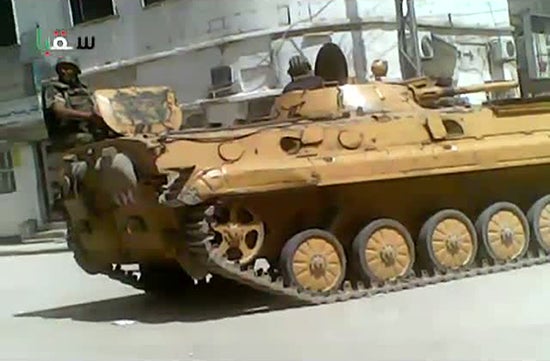During last year’s civil war in Libya, the Muammar Qadhafi regime’s weapon stockpiles were looted, and highly destructive arms quickly spread throughout Libya and the region. Twenty-one months into the revolution in Syria, the country is witnessing a similar experience.
Though the United States officially opposes the provision of weapons to Syria’s armed opposition and has discouraged Gulf States (e.g., Qatar and Saudi Arabia) from supplying arms, the Free Syrian Army (FSA) is proving resourceful in defending itself against the Assad regime’s attacks.
Targeting arms depots and military installations and salvaging the leftovers of battles, the FSA has seized surface-to-air missiles (also known as MANPADS), rocket-propelled grenades (RPGs), machine guns, armored vehicles, tanks, etc. Though offensive weapons such as tanks have been used by the FSA, they are difficult to operate, slow-moving, and easily targeted by the Syrian military. Rather, defensive arms such as anti-aircraft weaponry are the most effective for countering the military’s air strikes.
It is unclear how many MANPADS and other anti-aircraft weapons the FSA has in its possession or what percentage of them actually work. These weapons are, however, an equalizing force against the Syrian military. Furthermore, the opposition’s use of these weapons serves as a useful deterrent to a predominantly Sunni air force, of which many pilots have already defected. While the regime is composed of the largely Alawite minority, its ability to operate depends largely on the Sunni population to fill positions as bureaucrats and soldiers.
Regrettably, the FSA isn’t the only movement that has benefited from the regime’s weapons. Self-declared jihadists and Salafist groups, largely comprised of foreign fighters, have also targeted the regime’s military installations and equipped themselves with weaponry. According to the SecDev Foundation, last month, Ansar al-Islam, a hard-line Islamist group, captured approximately 15 MANPADS in Idlib, Aleppo, and the Damascus area. Though the FSA bears no official affiliation with extremist entities, the more desperate the FSA becomes in its need for resources, the more tempting it is for it to partner with well-resourced extremist groups.
The proliferation of arms by non-state actors is a major challenge for regional security. Syria’s northern neighbor Turkey is fearful that Syria’s Kurdish population would benefit from captured weapons and threaten Turkish security. Ankara has also requested Patriot missiles from NATO for fear that Syria’s chemical weapons could be used either by the regime or by terrorist entities.
Iran’s support for the Syrian regime has further contributed to regional instability. Hezbollah, with Iran’s backing, is operating in Syria and Lebanon and is believed to have been responsible for the assassination of Lebanon’s intelligence minister, Wissam al-Hassan, in October.
Furthermore, at the beginning of the crisis, Iran sent arms, technical resources, and the Quds Force—Iran’s elite guard—to aid the Syrian regime. Iran has continued to support the regime by shipping weapons to Syria using a major air corridor through Iraq. Iraq’s failure to inspect aircraft carrying weapons through its airspace has resulted in the flow of Iranian arms to Syria. The major supply route is responsible for Iran’s shipments of rockets, anti-tank missiles, RPGs, and mortars to Syria, according to The New York Times.
Though Syria’s opposition is more capable of defending itself, the Syrian regime still has allies in the region, unwilling to see President Bashar al-Assad fall. The longer the civil war drags out, the more challenging the recovery process will be. Terrorists embedded in the country, combined with the proliferation of arms, is a dangerous combination that will hinder the region for years to come.
